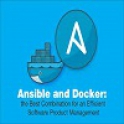Users Online
· Guests Online: 7
· Members Online: 0
· Total Members: 185
· Newest Member: meenachowdary055
· Members Online: 0
· Total Members: 185
· Newest Member: meenachowdary055
Forum Threads
Newest Threads
No Threads created
Hottest Threads
No Threads created
Latest Articles
DEMO - Continuous Delivery Using Docker and Ansible
 DEMO - Continuous Delivery Using Docker and Ansible
DEMO - Continuous Delivery Using Docker and AnsibleDevOps Courses |
| Categories | Most Recent | Top Rated | Popular Courses |
| Uploader | Date Added | Views | Rating | |
| Superadmin | 04.05.17 | 578 | No Rating | |
| Description | ||||
| Continuous delivery is fast becoming an indispensable practice for organizations that want to develop and deploy applications to production at speed with improved reliability. This course, Continuous Delivery Using Docker and Ansible, will teach you how to create a robust, production-class continuous delivery workflow that will test, build, release, and continuously deploy your applications in Docker containers. You'll learn how to create a portable workflow locally on your machine that you can invoke with a handful of simple commands, and then learn how to run your workflow in the popular Jenkins continuous delivery system using the new Jenkins pipeline plugin. Along the way, you will learn how to compose multi-container environments using Docker Compose, publish test reports, set up integration with GitHub and Docker Hub, and finally, deploy your application to Amazon Web Services (AWS), using the AWS CloudFormation service to define all of the infrastructure requirements for your application and AWS EC2 Container Service to run your Docker applications in production. By the end of this course, you'll have a better understanding of continuous delivery and how you can use Docker and Ansible to develop and produce better applications more efficiently than ever. Course Overview Course Overview2m Course Introduction Introduction4m Course Audience and Prerequisites3m Course Tour5m Continuous Delivery Overview3m How to Achieve Continuous Delivery2m Why Docker?2m Continuous Delivery Architecture3m Demo - Preparing Your Environment2m Installing Docker1m Installing Ansible1m Installing Other Tools1m Creating a Docker Virtual Machine3m Summary2m Creating the Sample Application Introduction3m Demo - Application Walkthrough2m Demo - Creating the Todobackend Web Service14m Demo - Unit and Integration Testing11m Demo - Acceptance Testing6m Demo - Testing the User Interface2m Summary0m Unit/Integration Testing using Docker Introduction1m Continuous Delivery Workflow2m Docker Image Hierachy3m Demo - Creating the Base Image5m Establishing the Virtual Environment5m Building the Base Image2m Demo - Creating the Development Image5m Creating Application Requirements Files2m Development Image Review2m Testing the Development Image8m Demo - Creating a Docker Compose Environment5m Running Tests using Docker Compose3m Waiting for a Dependent Service to Initialize4m Docker Compose Test Environment Review1m Summary1m Building Artifacts using Docker Introduction1m Continuous Delivery Workflow1m Application Artifact Types2m Demo - Building Application Artifacts6m Test and Build Consistency2m Adding a Builder Service4m Building and Publishing Python Wheels5m Summary1m Creating Releases using Docker Introduction3m Serving the Application5m Demo - Creating the Release Environment3m Creating the Release Image2m Describing the Release Image Part 11m Describing the Release Image Part 27m Testing the Release Image4m Demo - Bootstrapping the Application8m Bootstrapping the Application Review1m Demo - Acceptance Testing3m Running Acceptance Tests2m Continuous Delivery Workflow Review3m Summary1m Continuous Delivery Automation Introduction1m Demo - Using the Make Build System5m Creating a Makefile3m Describing the Workflow4m Parameterizing the Makefile5m Demo - Workflow Infrastructure4m Creating Docker Hub Repositories6m Summary1m Enhancing the Workflow Introduction2m Dangling Images and Volumes5m Improving User Feedback4m Self Containment5m Ensuring Self Containment4m Producing Test Reports2m Handling Failures and Errors8m Ensuring Consistency7m Configuring Consistency3m Tagging the Release Image8m Publishing the Release Image3m Docker Compose v2 Specification9m Summary1m Continuous Delivery Using Jenkins Introduction1m Demo - Setting up Jenkins Locally6m Configuring the Workflow in Jenkins4m Testing the Workflow1m Creating a Self Defined Workflow2m Test Failures1m Publishing the Jenkins Image1m Demo - Publishing Jenkins to AWS4m Initial AWS Setup3m AWS VPC Infrastructure3m Creating a CloudFormation Template1m Defining an EC2 Instance6m Defining Security Groups and Roles2m Defining Elastic Load Balancers1m Configuring the EC2 Container Service3m Configuring Stack Outputs1m Creating the Stack4m Demo - Integrating Jenkins with GitHub and Docker Hub2m Testing the Workflow2m Configuring GitHub Integration3m Configuring Docker Hub Integration1m Summary1m Continuous Deployment using Ansible Introduction1m Demo - Creating the Application Stack3m Configuring Autoscaling4m Configuring the Relational Database Service2m Configuring the Elastic Load Balancer and EC2 Container Service6m Demo - Creating an Ansible Deployment Playbook1m Deployment Walkthrough3m Configuring Access to AWS2m Creating the Playbook3m Creating the Stack Task4m Installing Custom Ansible Modules3m Deploying the Application5m Testing the Playbook5m Demo - Continuously Deploying the Application using Jenkins3m Creating the Jenkins Deployment Job4m Continuously Deploying New Releases4m Summary1m | ||||
Ratings
Comments
No Comments have been Posted.
Post Comment
Please Login to Post a Comment.
